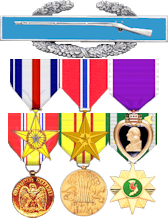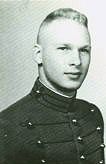Robert George KeatsCullum: 25736 Class: 1965 Cadet Company: E2 Date of Birth: April 18, 1944 Date of Death: February 2, 1968 - in Vietnam due to hostile action Age: 23 years, 10 months and 16 days young. - View or Post a Eulogy Interred: West Point Cemetery, West Point, NY Location: Sect XXXIV, Row D, Grave 172 |

|
 ROBERT GEORGE KEATS was born in Memphis, TN, on 18 Apr 1944 to
Robert
L. and Margaret Anne Keats. As a young boy he was enthralled with a
board game based on the battle of Gettysburg, and he read military
history avidly. While other boys his age were memorizing baseball and
football cards, Bob memorized the names of all the Confederate generals
in the Civil War and the major battles in which they participated. That
interest in history undoubtedly provided the spark for his informing
his parents when he was in elementary school that he wanted to attend
West Point. After his family moved to Illinois, he remained very
interested in the military academy, and a visit to West Point in
January 1961 confirmed his desire to join the Long Gray Line. He
ultimately received two appointments, one from his senator and another
from his congressional representative, both of whom must have
recognized that Bob would be an ideal cadet.
ROBERT GEORGE KEATS was born in Memphis, TN, on 18 Apr 1944 to
Robert
L. and Margaret Anne Keats. As a young boy he was enthralled with a
board game based on the battle of Gettysburg, and he read military
history avidly. While other boys his age were memorizing baseball and
football cards, Bob memorized the names of all the Confederate generals
in the Civil War and the major battles in which they participated. That
interest in history undoubtedly provided the spark for his informing
his parents when he was in elementary school that he wanted to attend
West Point. After his family moved to Illinois, he remained very
interested in the military academy, and a visit to West Point in
January 1961 confirmed his desire to join the Long Gray Line. He
ultimately received two appointments, one from his senator and another
from his congressional representative, both of whom must have
recognized that Bob would be an ideal cadet.
At West Point Bob was an outstanding student and leader who was never too busy to assist his classmates who needed help with academics. He also found the time and energy to participate in a wide variety of extracurricular activities. He took great pride in being a regular writer for the Pointer and having prepared the memorial article for GEN Douglas MacArthur. In addition to teaching Sunday School all 4 years, Bob remained active in the Boy Scouts; one of his major accomplishments was coordinating the West Point Jamboree. As a cadet he maintained his interest in history and in 1964 proposed the formation of a history club to the Head of the Department of History. He eventually became the club’s first president. Had fate not intervened, he would have returned to West Point as an instructor in the Department of History.
After graduation Bob completed Airborne and Ranger schools and then joined the 2d Battalion, 23d Infantry in Korea, where he distinguished himself as a platoon leader. After returning from Korea, he married his high school sweetheart, Susan Van der Vries, in December 1966, and they moved to Ft. Polk, where he served in a Basic Training unit. Here, as in Korea, Bob excelled, demonstrating great leadership and concern for his soldiers; he took particular pride in creating a cohesive unit and in 100 percent of his trainees graduating. While a platoon leader, his great energy, enormous talent, and compassion as a leader enabled his platoon to achieve extraordinarily high individual and platoon scores, setting all-Army records. His outstanding success as a platoon leader resulted in his quickly assuming command of a company. Though Bob was making an important contribution, he felt he could make a larger contribution elsewhere, and he soon volunteered for duty in Vietnam.
Bob arrived in Vietnam in late October 1967, just as he was promoted to captain at the age of 23, and reported to the 2d Battalion, 47th Infantry, 9th Infantry Division. Though he asked to be assigned immediately to an infantry company, he had to serve as a battalion S-1 for 3 months before assuming command of B Company in January 1968. Within an hour after taking command, he was ordered to take his company out on a search and destroy mission. Other missions quickly followed. Ten days after taking command, Bob’s company went to the aid of one of his platoons that had come under enemy attack. Knowing that a sweep through a nearby hamlet would be extremely dangerous, he asked for volunteers. Twenty of his soldiers willingly went with him, even though he had been in command for only a brief period. As he and the volunteers moved forward, they came under heavy enemy fire. To call in preplanned mortar fire, Bob immediately dashed to his forward observer’s position through a hail of enemy fire. When this supporting fire began, Bob led his men in an assault on the enemy position but was mortally wounded. For his valor he was awarded the Silver Star posthumously Thus, he died as he had lived, fulfilling his responsibilities, leading others, and fighting for something important to him.
When Bob was buried at West Point, a letter he had written as a cadet was read at the service. That letter included a strong affirmation of Bob’s Christian faith and his assertion that he was an “idealist.” He wrote: “I am in a fight to save the ideal now. I shall be until the day I die. The world can only be saved by people who are striving for the ideal. I know we shall win, it can be no other way.” He concluded, “The fight goes on, and will go on until it is won. There can be no reneging on responsibility. When a comrade-in-arms falls to the beast, another must take his place, to rise up, to fight again, to fight to the death if necessary.”
Bob lived his life, and he died, as an idealist. Whether in the classroom or in other activities, Bob’s friends and classmates always regarded him as a high-minded, idealistic, and reverent person. He never hid his faith, and he never reneged on his responsibilities. The tragedy of Bob’s early death was not only the personal loss for his family but also the loss of the innumerable contributions that an idealistic, talented man such as he could have made.
A classmate

